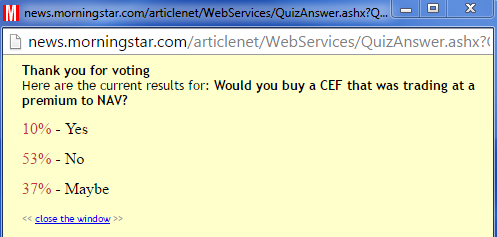Would you ever buy something worth $1 for $1.01 or more?
Would you ever buy something worth $1 for $1.01 or more?
This is a question Morningstar recently posed in an article about Closed-End Funds (CEFs) on their website. The exact question was, “Would you ever buy a CEF that was trading at a premium to NAV?” and can be read here. Surprisingly, only 53% of respondents answered that they would not buy a CEF at a premium. The screenshot below shows the results from the poll that they conducted.

We would never advise anyone to purchase a CEF at a premium to net-asset value (NAV) and the results of the Morningstar poll show just how many investors don’t understand how these funds are valued or trade. Simply put, we ask why you would ever want to buy a fund for more than its basket of goods is worth, especially when you often can find a fund with a similar portfolio that is trading at a discount of $0.99 or less on the dollar.
Closed-end funds are investment companies that invest in a bundle of securities, similar to a mutual fund, that are publicly traded on exchanges. We have written before about CEFs and how they typically trade at a premium or discount to their NAV. (Would You Like to Buy $1 for 85¢?) The Morningstar article has several key points we agree with when it comes to purchasing CEFs including never buying at the initial public offering (IPO) and purchasing at a good relative discount.
An investor would never want to purchase a CEF at the IPO because all of them trade at a premium. This is caused by all of the fees associated with opening a new fund including legal and underwriting fees. As an example, a fund sells a single share at the IPO at $20 and then pays $1 to cover all of the fees to open the fund. This leaves the fund manager to only invest $19 in the fund’s strategy. Therefore, you would have just purchased $19 worth of goods for $20. Investors often purchase CEFs at IPOs due to brokers who receive commissions for selling these funds and currently don’t have to adhere to a fiduciary standard.
A majority of CEFs trade at a discount to their net-asset value according to data from cefconnect.com. As of Sep. 2, there are 544 active CEFs and 415, or about 76%, of all funds trade at a discount to NAV. With the majority of funds trading at a discount to their NAV, using relative discounts helps uncover value in CEFs if you are able to purchase a fund trading at a discount to its average or high 52 week discount. For example, if a fund has a 52 week average discount to NAV of 10% and a 52 week high discount of 15% and is currently trading at a 14% discount, it is trading at a good relative discount as it is close to the highest discount it has been over the previous year. Using statistics also helps when measuring relative discounts and is explained more in the Morningstar article linked above.
Another advantage to purchasing CEFs at a discount is the yield advantage that an investor is able to obtain. The yield advantage from a CEF that pays distributions is a result of purchasing the fund at a discount, which in turn leads to a higher yield when calculated in actual dollars. For example, a mutual fund and CEF both have a yield of 5% to their NAV which is $20. If the CEF is purchased at a 10% discount to NAV or a price of $18, the yield will now be 5.56% or the distribution ($1) divided by the market price ($18). Although this is an advantage of purchasing CEFs at a discount, we never recommend buying a fund solely based on its yield.
These are just three of the several ways investors can profit from investing in closed-end funds. Price appreciation, narrowing of the discount, share buybacks, liquidation, rights offerings, tender offerings, and activism are all ways investors can make money in CEFs. If you have any questions about closed-end fund investing or would like to learn more about how Blue Bell Private Wealth Management invests in closed-end funds please call at (610) 825-3540.


Access your personal financial planning home page. Your homepage allows you to organize, store, and monitor all your personal financial information, including access to all of your accounts, credit cards, mortgages, insurance, and investments from a wide range of sources.
As a client of Blue Bell Private Wealth Management, LLC (“Company”), by selecting the “I Agree” button, I elect to participate in the password-protected access portion of Company Internet web site. I understand that my participation will allow me to review certain investment-related information published by Company and unaffiliated third parties. This password-protected access is made available to clients of Company free of charge. This authorization shall continue until canceled in writing.
I understand that the password-protected section is a secure web site intended only to allow a client access to information relative to his/her/its specific account. I also understand that I will be assigned an individual password. I agree not to share my password with any other person. I hereby release and hold Company harmless from any adverse consequences relative to any failure by me to keep the identity of my password secure.